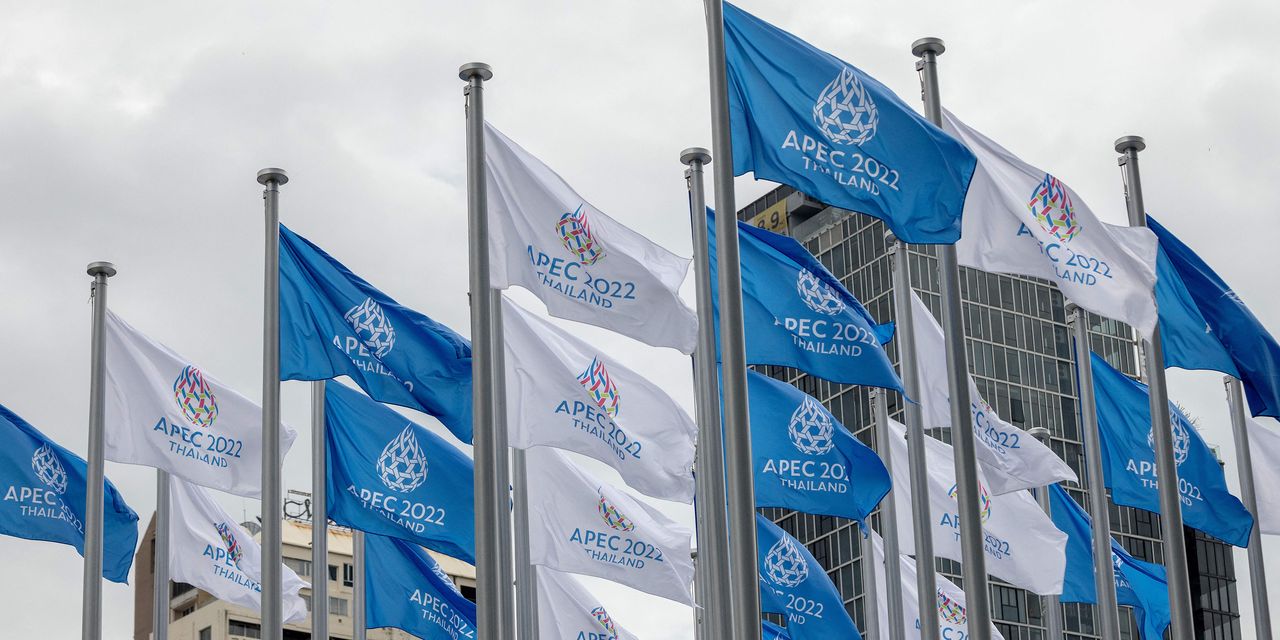About the authors: Kurt Tong is managing partner at The Asia Group and was previously the U.S. chief of mission in Hong Kong and U.S. ambassador for the Asia-Pacific Economic Cooperation group. Chuin Wei Yap is program director for international trade research at the Hinrich Foundation. He previously was a trade policy manager with Singapore’s Ministry of Trade and Industry and a Wall Street Journal correspondent.
What a difference a dozen years can make.
The last time the U.S. took the chair of the Asia-Pacific Economic Cooperation forum, in 2011, the regional economic policy conversation was all about market opening.
Negotiations for a Regional Comprehensive Economic Partnership linking the 10 Association of Southeast Asian Nations economies to six other regional partners including China were just getting organized. The U.S.-brokered Trans-Pacific Partnership, setting new and higher standards for market opening, was in its third year of negotiations and looking strong—attracting Japan, while excluding China.
Fast forward to 2023. The U.S. is once again the APEC host and will convene a leaders’ summit in San Francisco in November. But the economic policy landscape looks very different.
Now, discussions are mostly about reshaping supply chains to fit geopolitical imperatives. National leaders talk about “friend-shoring,” and are exploring massive new subsidy programs to try to bend manufacturing activity to fit within their borders. The U.S. is directing the main part of its policy effort toward creating barriers to doing business with China. Relatively little effort is being directed toward deepening its economic ties to its preferred partners in Asia and the Pacific.
Everywhere, economic policy leaders are talking about mitigating risk, rather than talking about creating opportunity.
When Asian economic leaders look to Washington, they mostly see a focus on export controls, investment restrictions, and nationality-based subsidies.
The U.S. abandoned in 2017 the Trans-Pacific Partnership, and instead launched the Indo-Pacific Economic Framework in 2022. Asian and Pacific partners find the new framework confusing and uninspiring—but are still open to exploring it, a testament to the region’s abiding interest in working with the U.S.
In Asia, major trading economies like Japan, Vietnam, Singapore, and South Korea have grown accustomed to operating in the narrow straits between jousting superpowers. But they will face more challenging choices in the coming years, particularly on trade and investment relationships, as the strategic contest between Washington and Beijing deepens.
Take, for example, the friend-shoring concept that Washington has espoused. It is easy enough to grasp what the term means in a political sense: policy makers would prefer that sensitive technologies be traded among allies, rather than adversaries.
But investment and manufacturing decisions are hard to reverse once put in motion, especially when they involve multiple jurisdictions. As a practical matter, it is difficult for private companies and foreign governments to predict how restrictive the new friend-shoring rules will become and calculate future business costs in the real world.
Moreover, one nation’s friend-shoring—which sometimes is just another word for “on-shoring”—can be another nation’s unfriendly trade distortion. One jurisdiction’s captured employment can be another jurisdiction’s inflation.
Now, major global economies are crafting their own industrial policies, in imitation of the U.S. CHIPS and Science Act and the Inflation Reduction Act. Governments from Tokyo to Brussels are putting their budgets behind a range of trade-distorting subsidies to match America’s.
Economists worry that the recent post-Covid emphasis on economic security and supply chain integrity will result in lower incomes and higher prices, on a global basis.
Political historians like ourselves, however, worry about something else. We worry that by concentrating primarily on pushing away China, the U.S. is missing opportunities to draw the rest of Asia closer.
This is as much as anything a matter of leadership emphasis.
President Biden has personally spoken often and acted frequently on issues related to the military security of the Western Pacific, always with concern about China in the foreground. His list of geopolitical and diplomatic accomplishments is impressive and comes in a variety of bilateral and mini-lateral constellations, such as the U.S.-Australia-United Kingdom military pact and the U.S.-India-Japan-Australia quadrilateral leaders’ process.
But President Biden has been virtually silent on the purpose of hosting APEC in 2023. Neither has he spoken to the substance and reasoning of the 14-member Indo-Pacific Economic Framework since its launch almost a year ago.
When he visited Washington in January, Japanese Prime Minister Fumio Kishida drew from his new National Security Strategy to make a clear and almost impassioned statement about the importance of Group of Seven nations reaching out to the Global South and focusing on their key concerns—which are all related to economic development. The U.S. media, however, only reported on Kishida’s expanded military expenditure plans.
The Washington echo chamber, in choosing to focus on zero-sum economic combat rather than plus-sum economic cooperation, may be setting itself up for a fall.
This is not just an economic policy problem. It is a geopolitical risk. Washington’s failures in global economic engagement may ultimately undermine its successes in the military and diplomatic spheres.
APEC is a looming test for the White House. Can President Biden use this trans-Pacific opportunity to craft inclusive economic policy achievements that are consistent with U.S. national objectives, and resonate in Asian capitals? Can the U.S. sort through the long agenda it has proposed for the Indo-Pacific Economic Framework to find some concrete and meaningful agreements to harvest in the near term?
There is a window of opportunity for some consequential successes in 2023, but that window is narrowing fast.
Guest commentaries like this one are written by authors outside the Barron’s and MarketWatch newsroom. They reflect the perspective and opinions of the authors. Submit commentary proposals and other feedback to [email protected].
Read the full article here










